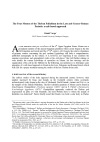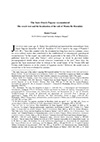Daniel Varga
« The Four Montus of the Theban Palladium in the Late and Graeco-Roman Periods: a cult-based approach »
ENiM 14, 2021, p. 315-322.
 Lãûˋtude traite de quelques mûˋthodologies et dãapproches possibles concernant le culte de Montou dans les temples du palladium thûˋbain (Mûˋdamoud, Karnak Nord, Ermant, TûÇd) dans les ûˋpoques tardives, ptolûˋmaû₤que et romaine. Un bref rûˋsumûˋ de lãhistoire et de lãûˋtat actuel de la recherche est ûˋgalement inclus.
Lãûˋtude traite de quelques mûˋthodologies et dãapproches possibles concernant le culte de Montou dans les temples du palladium thûˋbain (Mûˋdamoud, Karnak Nord, Ermant, TûÇd) dans les ûˋpoques tardives, ptolûˋmaû₤que et romaine. Un bref rûˋsumûˋ de lãhistoire et de lãûˋtat actuel de la recherche est ûˋgalement inclus.
 The study deals with some methodological possibilities and suitable approaches regarding the cult of Montu in the temples of the Theban Palladium (Medamud, North Karnak, Armant, Tod) during the Late, Ptolemaic and Roman Periods. A brief overview of the research history and the current state of research are also included.
The study deals with some methodological possibilities and suitable approaches regarding the cult of Montu in the temples of the Theban Palladium (Medamud, North Karnak, Armant, Tod) during the Late, Ptolemaic and Roman Periods. A brief overview of the research history and the current state of research are also included.
 Consulter cet article (19804) -
Consulter cet article (19804) -  Télécharger cet article au format pdf (11213)
Télécharger cet article au format pdf (11213)
« The Saite Oracle Papyrus reconsidered. The oracle text and the localization of the cult of Montu-Re-Harakhty »
ENiM 17, 2024, p. 101-127.
 Depuis sa premiû´re publication par R. Parker, le papyrus oraculaire de Brooklyn (P. Brooklyn 47.218.3) a longtemps ûˋtûˋ utilisûˋ comme source principale pour les ûˋtudes socio-culturelles visant û identifier les dignitaires thûˋbains des 25e-26e dynasties et û reconstituer leurs gûˋnûˋalogies. En revisitant son texte dãoracle, la prûˋsente ûˋtude traite les circonstances de la consultation oraculaire et de son rûˋsultat puisque la pûˋtition publique porte sur un transfert de service du culte dãAmon û celui de Montou, cãest-û -dire les deux divinitûˋs les plus importantes de Thû´bes et sa rûˋgion. Une attention particuliû´re est attachûˋe au toponyme Iwnw-Sma, dûˋsignant clairement le temple de Montou û Ermant et non û Karnak, ainsi quãû dãautres sources contemporaines appartenant au personnel hermonthite du dieu.
Depuis sa premiû´re publication par R. Parker, le papyrus oraculaire de Brooklyn (P. Brooklyn 47.218.3) a longtemps ûˋtûˋ utilisûˋ comme source principale pour les ûˋtudes socio-culturelles visant û identifier les dignitaires thûˋbains des 25e-26e dynasties et û reconstituer leurs gûˋnûˋalogies. En revisitant son texte dãoracle, la prûˋsente ûˋtude traite les circonstances de la consultation oraculaire et de son rûˋsultat puisque la pûˋtition publique porte sur un transfert de service du culte dãAmon û celui de Montou, cãest-û -dire les deux divinitûˋs les plus importantes de Thû´bes et sa rûˋgion. Une attention particuliû´re est attachûˋe au toponyme Iwnw-Sma, dûˋsignant clairement le temple de Montou û Ermant et non û Karnak, ainsi quãû dãautres sources contemporaines appartenant au personnel hermonthite du dieu.
 Since its first publication by R. Parker, the Saite Oracle Papyrus (P. Brooklyn 47.218.3) has long been used as a primary source for socio-cultural studies aiming at identifying Twenty-fifth and Twenty-sixth Dynasty Theban dignitaries and reconstructing their genealogies. By revisiting its main oracle text, the present study focuses on the circumstances of the oracular consultation and its outcome since the public petition is concerned with a transfer of service from the cult of Amun to that of Montu, i.e. the two most prominent deities of Thebes and its surroundings. Particular attention is paid to the toponym Iwnw-Sma, clearly designating the temple of Montu at Armant and not in Karnak, as well as other contemporary sources belonging to the personnel of the god at Armant.
Since its first publication by R. Parker, the Saite Oracle Papyrus (P. Brooklyn 47.218.3) has long been used as a primary source for socio-cultural studies aiming at identifying Twenty-fifth and Twenty-sixth Dynasty Theban dignitaries and reconstructing their genealogies. By revisiting its main oracle text, the present study focuses on the circumstances of the oracular consultation and its outcome since the public petition is concerned with a transfer of service from the cult of Amun to that of Montu, i.e. the two most prominent deities of Thebes and its surroundings. Particular attention is paid to the toponym Iwnw-Sma, clearly designating the temple of Montu at Armant and not in Karnak, as well as other contemporary sources belonging to the personnel of the god at Armant.
 Consulter cet article (10555) -
Consulter cet article (10555) -  Télécharger cet article au format pdf (4617)
Télécharger cet article au format pdf (4617)
ENiM 15 - 2022
18 article(s) - 29 octobre 2024.
ENiM 1 à 17 (2008-2024) : 219 articles
3 622 017 téléchargements
6 459 394 consulations.
Index des auteurs

Mots clés

Derniers articles : 
TDENiM - Mise en ligne des volumes ûˋpuisûˋs : 
CENiM - Mise en ligne des volumes ûˋpuisûˋs : 
 Jean-Claude Grenier L'Osiris ANTINOOS, CENiM 1, Montpellier, 2008 — (26 dûˋcembre 2008)
Jean-Claude Grenier L'Osiris ANTINOOS, CENiM 1, Montpellier, 2008 — (26 dûˋcembre 2008) 
 Twitter
Twitter 3396986 visites - 819 visite(s) aujourd’hui - 113 connecté(s)
© ENiM - Une revue d’égyptologie sur internet
Équipe Égypte Nilotique et Méditerranéenne - UMR 5140 - « Archéologie des Sociétés Méditerranéennes » (Cnrs) - Université Paul Valéry - Montpellier III


 , éÀnnw.w / éÀnn.w, ô¨ manoeuvres dormantes ô£
, éÀnnw.w / éÀnn.w, ô¨ manoeuvres dormantes ô£






 Contact
Contact
 Abonnez-vous !
Abonnez-vous ! Équipe Égypte Nilotique et Méditerranéenne
Équipe Égypte Nilotique et Méditerranéenne UMR 5140 « Archéologie des Sociétés Méditerranéennes » (Cnrs)
UMR 5140 « Archéologie des Sociétés Méditerranéennes » (Cnrs) Université Paul Valéry - Montpellier III
Université Paul Valéry - Montpellier III